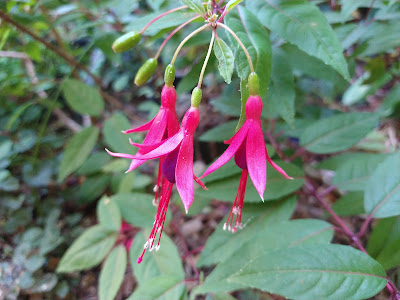
Sacramento Fuchsia Society hosts annual event at Shepard Center

|
|
Angel Earrings are right at home in a shady
Sacramento backyard. (Photo: Debbie Arrington)
|
One of the prettiest flower shows in Sacramento returns Saturday when the Sacramento Fuchsia Society hosts its annual show and sale at Shepard Garden and Arts Center. Admission and parking are free.
Set for 10 a.m. to 4 p.m. Saturday, June 4, this one-day show is a wonderful opportunity to learn about fuchsias – and take some home, too.
Scores of plants, many grown by local club members, will be offered for sale including several varieties that are heat resistant and well adapted to Sacramento area gardens. Both bush and cascading varieties will be available.
For example, Angel Earrings – a dainty pink and purple cascading fuchsia – thrives in dappled summer shade. It’s lovely spilling out of a hanging basket on a covered patio or in a flower bed under trees.
Most heat-tolerant fuchsias bloom profusely from late April through summer into fall. To look their best, they need consistent irrigation (don’t let them dry out) and (at least) afternoon shade.
Find out more Saturday! Club members will offer advice as well as display their most beautiful plants and blooms. See dozens of varieties.
Shepard Center is located at 3330 McKinley Blvd., Sacramento.
Directions and details: www.sgaac.org .
Comments
0 comments have been posted.Sacramento Digs Gardening to your inbox.
Sites We Like
Garden Checklist for week of April 14
It's still not warm enough to transplant tomatoes directly in the ground, but we’re getting there.
* April is the last chance to plant citrus trees such as dwarf orange, lemon and kumquat. These trees also look good in landscaping and provide fresh fruit in winter.
* Smell orange blossoms? Feed citrus trees with a low dose of balanced fertilizer (such as 10-10-10) during bloom to help set fruit. Keep an eye out for ants.
* Apply slow-release fertilizer to the lawn.
* Thoroughly clean debris from the bottom of outdoor ponds or fountains.
* Spring brings a flush of rapid growth, and that means your garden needs nutrients. Fertilize shrubs and trees with a slow-release fertilizer. Or mulch with a 1-inch layer of compost.
* Azaleas and camellias looking a little yellow? If leaves are turning yellow between the veins, give them a boost with chelated iron.
* Trim dead flowers but not leaves from spring-flowering bulbs such as daffodils and tulips. Those leaves gather energy to create next year's flowers. Also, give the bulbs a fertilizer boost after bloom.
* Pinch chrysanthemums back to 12 inches for fall flowers. Cut old stems to the ground.
* Mulch around plants to conserve moisture and control weeds.
* From seed, plant beans, beets, cantaloupes, carrots, corn, cucumbers, melons, radishes and squash.
* Plant onion sets.
* In the flower garden, plant seeds for asters, cosmos, celosia, marigolds, salvia, sunflowers and zinnias.
* Transplant petunias, zinnias, geraniums and other summer bloomers.
* Plant perennials and dahlia tubers for summer bloom.
* Mid to late April is about the last chance to plant summer bulbs, such as gladiolus and tuberous begonias.
* Transplant lettuce seedlings. Choose varieties that mature quickly such as loose leaf.